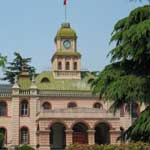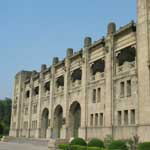
Site of
Provisional Senate of the Republic of
China. |
Riding their bicycles past it
every day, Nanjing residents are very familiar with the complex of elegant, old
two- and three-storey houses along Zhongshan Avenue, amidst a forest of modern
structures.
The houses, located in the downtown area, are set apart from the bustle of
the world, behind 2-metre-high walls covered with fragrant roses.
They and other buildings completed after the First Opium War (1840-42) in the
capital of East China's Jiangsu Province, especially those built when Nanjing
served as the national capital from 1912 to 1949, are an important and unique
part of the architectural history of the country.
"The more than 1,000 existing buildings built in China's Republican minguo
Era, mostly in the 1920s and 30s, document a transitional stage in which modern
Chinese architects were seeking and achieving an independence from the
overwhelming influence of architectural trends in the Western world," said Liu
Xianjue, professor with the architecture department of Southeast University in
Nanjing.
"It was a time when the first generation of architects returned after their
studies abroad. The modern ideas in their minds clashed with the national
patriotism in their hearts roused by the semi-colonial society."

Site of
Marlin Hospital. |
Many of the Republican
Era buildings in Nanjing that were designed by top architects of the time are
now under the protection of a plan drafted by the Nanjing Urban Planning
Institute and approved last year by both the government and the city's
residents.
The institute revealed its plan in an exhibition last year, which
surprisingly turned out to be the most popular exhibition of the year.
Faced with the city's rampant urban construction, the plan calls for
protection of both those architectural structures that have been listed as
cultural heritage sites at the national, provincial or municipal level, and
those that haven't, said Liu Zhengping, the institute's chief designer.
It included 134 buildings, which were selected by the city's residents after
the institute published a list of candidates on the media early last year, with
the final choices being made by a group of scholars and authorities.
Protection and restoration work has been intense this year, as the city is to
host the World Historical and Cultural Cities Expo from April 30 to May 5.

Site of
Central Stadium, which was built in
1931. |
The expo involves more than 20
ancient cities from China and abroad, including Barcelona, Daejeon, Florence,
Kyoto, Leipzig, Malacca, Nagoya, St Petersburg and Vienna.
Mayors of the cities attending are to present a declaration on the protection
of world historical and cultural cities at the expo, which is being organized by
the Chinese Ministry of Culture, Ministry of Construction, State Administration
of Cultural Heritage and the Chinese National Committee for the United Nations
Educational, Scientific and Cultural Organization (UNESCO).
Among ancient cities, Nanjing's charm lies partly in its modern architecture,
which demonstrates a clear line of development from 1840 to 1949, said city
spokeswoman Xu Ning.
One of the earliest extant pieces of modern architecture in Nanjing, which is
well preserved on the campus of Jinling Middle School, is the bell tower of the
Huiwen Academy, which was built by the United States Society of Jesus in 1888.
The buildings of the academy, designed by US architects, were in the American
Colonial style typical of the architecture of New England, which had its origins
in Europe.
The brick tower has a finely decorated base and eaves.
Representative works of Western architects in Nanjing include the American
Colonial Style buildings of the Jesuit Hospital, which was opened in 1892 by the
US Jesuit Society, and was known among Nanjing residents as the "Marlin
Hospital," after its first president, a Canadian whose surname was Marlin.
The buildings are still in use today as part of the Gulou Hospital.
Modern buildings mushroomed in Nanjing after 1898, when foreigners forced the
country to open the city's Xiaguan Harbour on the Yangtze River to Western
tradesmen and missionaries.
Reformists of the Qing Dynasty (1644-1911) were also enthusiastic about such
buildings. The Jiangsu provincial senate building, completed in 1909, was in the
French Renaissance Style.
Changes took place in the early 1920s when young Chinese architects, born at
the turn of the century, returned after being educated in Japan, the United
States and Europe and opened their own offices. Among them are many names that
are still remembered, including Lu Yanzhi (1894-1929), a graduate of Cornell
University; Guan Songsheng (1891-1960), a graduate of Harvard University; Liu
Guozhen (1897-1968), a graduate of the Tokyo Engineering Academy; Zhuang Jun
(1888-1990), a graduate of Illinois University; Xu Jingzhi (1906-), a graduate
of Michigan University, to mention some of the most famous.
It was some of these young men who started modern architectural training and
research in China, with the founding in 1923 of the country's first department
of architecture in the Suzhou Engineering School, which became part of Central
University in 1928 and is today the architecture department of Southeast
University.
In 1928 some of these young men founded the department of architecture in
Northeast University, which became part of Peking University in 1938.
They organized the Chinese Architects' Society in 1927 and published a
monthly journal.
Architectural work in Nanjing was given a great boost by the formulation of
the "Capital Plan" in 1929.
Under the plan, American architect Henry M. Murphy (1877-1954), the chief
designer and his assistant, also his student Lu Yanzhi decided the major avenues
of downtown Nanjing today and divided the city into six districts: the central
public affairs, municipal public affairs, industrial, commercial, educational,
cultural, and residential districts.
"Looking back at the history from our vantage point today, we can see that
the basic layout of Nanjing has not been left to us by the Southern Dynasties
(AD 420-589) or the Ming Dynasty (1368-1644), which had the city its capital,
but by the Republic of China," said Liu Xianjue, who was the student of famous
architects Yang Tingbao (1901-83) and Liang Sicheng (1901-72).
The plan encouraged the construction of buildings of the Chinese Palatial
Style and with modern structural features. Most major public buildings built at
the time in Nanjing were of this type.
Typical were the buildings of the then Executive Yuan (central executive
organ), the Ministry of Transportation, the Central Research Institute and the
Central Museum, which are all well preserved and still in use, said Liu
Zhengping.
The crowning work of this style of architecture is the Dr Sun Yat-sen
Mausoleum, designed by Lu Yanzhi in 1925.
Located on the southern side of Purple Mountain, the mausoleum covers 80,000
square metres, the imposing structure matches the character of Sun, and also
established the status of the then 31-year-old architect.
Despite their impressive appearance, buildings in the Chinese Palatial Style
were costly and sometimes flawed in design detail.
Adventurous Chinese architects then abandoned the complexities, heavy roofs
and exterior decoration of the Chinese Palatial Style, and adopted the flat
roofs and simple structure of modern buildings, but they maintained Chinese
structural components and decorations at such parts as eaves, entrances and
windows.
This became known as the Chinese Neo-ethnic style.
Typical buildings include those of the then Ministry of Foreign Affairs
(completed in 1933), the Citizens' Great Hall (1935), the National Art Museum
(1935), Central Hospital (1933), Central Stadiums (1933) and the Music Terrace
of Dr Sun Yat-sen's Mausoleum.
The Central Stadium, designed by Yang Tingbao, was at that time the largest
stadium complex in the Far East, covering 800,000 square metres. The complex is
used today by the Nanjing Sports Institute.
The architects showed their mastery of Western-style designs best in the
Yihelu Community, which consists of more than 340 two- and three-storey houses,
each with a garden.
The quiet community, hidden in a triangular area beside the Shanxilu and
Hunanlu shopping centres in the downtown, is a collection of Western styles such
as Classical, Neo-Classical, Neo-Romanesque, Regency and Spanish.
The houses were embassies and homes of high-ranking officials in the
Kuomintang government.
Today mostly ordinary citizens live in these homes with their grapevine
covered courtyards and rose sheds.
The Yihelu community and the Meiyuan Xincun community, where old houses are
clustered, are now protective zones where the municipal government requires
residents to maintain the exterior appearance of the houses, said Liu Zhengping.
The homes of Wang Jingwei (1883-1944) and George Marshall (1880-1959), US
President Truman's special representative to China, in the Yihelu community, are
cultural heritage sites under the Cultural Heritage Protection Law.
Stress is put on the protection of the more than 40 buildings built in the
1920s and 30s along Zhongshan Avenue which cuts through downtown Nanjing.
Inappropriate structures around the protected buildings are being taken down
to display the protected buildings to the best effect.
The campuses of Central University (today's Nanjing University and Southeast
University) and Jinling Women's University (Nanjing Normal University), site of
the Central Research Institute, which is used today by the Nanjing Institute of
Geology and Paleontology, Chinese Academy of Sciences, have been listed as
cultural heritage sites at the provincial level.
Not only buildings at the sites but also any surroundings that are in harmony
with the buildings are also under protection, said Liu Zhengping.
The protective measures are expected to give full play to the cultural and
historical aspects of this economically powerful city in the Yangtze River
Delta, said Xu Ning.
Experts say it is easier to protect the old city of Nanjing than most other
ancient Chinese cities, as the city has a modern urban planning base that is no
more than a century old.